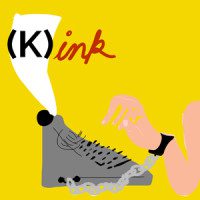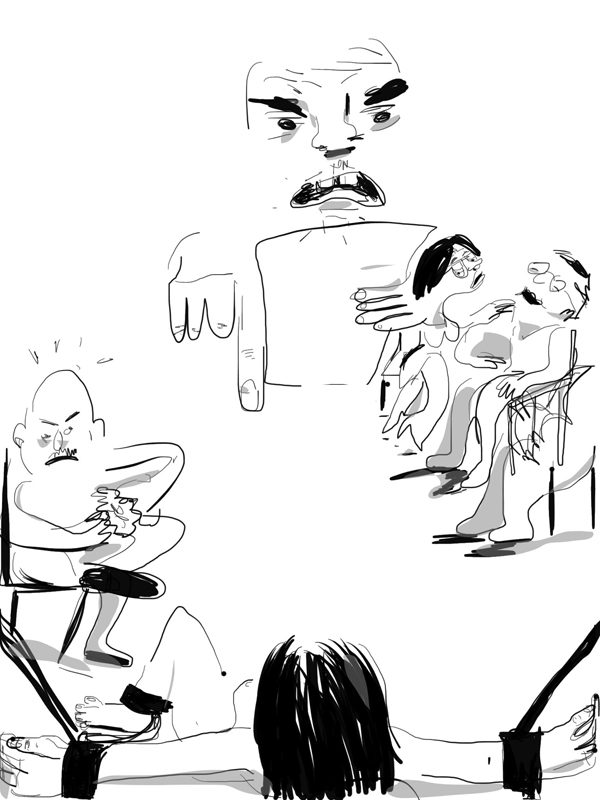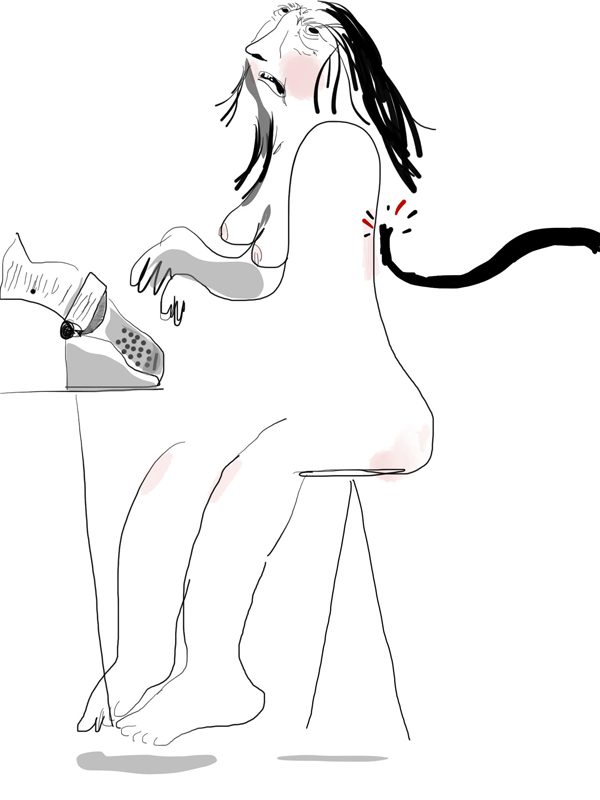There’s evidence that D.H. Lawrence enjoyed an erotic power exchange relationship with his wife, that James Joyce was into scat (among other things), and that Oscar Wilde—well, most of us know what Oscar Wilde liked. These literary geniuses explored radical sexual agency and desire in their work and in their relationships, but little beyond rumors and personal letters exist to tell us what they themselves thought of their turn-ons and the ways in which those dovetailed with their writing. Even if space for such a discourse and community had existed back then, Lawrence, Joyce and Wilde couldn’t freely discuss their sexuality. As it was, they faced censorship and generated scandal wherever they went, and of course Wilde went to prison for his sexual behavior.
Although our world is still intolerant of sexual difference, I want to believe we’re at a point where people can speak openly about the consensual ways we express our erotic selves. And I’m interested in the connections between those private expressions and the larger, more public work we do in the world. This series is meant as a forging of community; a validation of that which gets called sexual deviance; and a proud celebration of the complex, fascinating ways that humans experience desire.
In this ongoing series of short personal essays, writers in all genres—novelists, poets, journalists, and more—explore the intersection between our literary lives and practices and our BDSM and fetishistic lives and practices. In other words, these essays aren’t about writing about non-normative sex: rather, it’s a series about how looking at the world through the lens of an alternative sexual orientation influences the modes and strategies with which one approaches one’s creative work.
If you have questions or comments, or if you’re a writer who would like to contribute, please contact me at kinkwriting@gmail.com.
–Arielle Greenberg, Series Editor
***
On Using Dangerous Tools and Toys
I am naked. I have put everything on the page, given all my thoughts away. My words are vulnerable to a stranger’s opinion.
I am naked. I have revealed everything, my body here for all to see. I give it up. My flesh is vulnerable to the elements, to strangers’ eyes.
*
I am an emerging writer and fairly young kinkster. The letters on my keyboard are just starting to fade; the leather of my cuffs is just starting to crack. To excel at either of these paths—writing or BDSM—takes years of practice. There is a reason why we build communities of writers through which we hope to find support and encouragement: having that community makes us better. Community is also very important in the BDSM world—not only because we may enjoy being among those like ourselves, but because we play with dangerous emotions and sometimes use fire or blades as toys. Both the emotions and the toys require support and understanding and, most would agree, education, before we pull them out.
One should be mindful of the dangers—and joys—of both writing and BDSM. Sharing our writing can be just as scary as trying that new braided whip, that new one you know will hurt like a motherfucker but want, just to see how much you really can take.
Remember that old saying, Sticks and stones may break my bones, but words can never hurt me? It’s not true. Fire and blades, sticks and stones, and words have the potential to be dangerous tools and toys, but I’m learning how to use them all as tools of empowerment. As a writer and a bottom, I find my strength through choice. I choose to be vulnerable, to let myself be so on my own terms. I make myself vulnerable when I share my writing and when I try those new toys. Through negotiated, temporary, outward vulnerability, I achieve a sense of control and power, both of myself and of my environment—whether that’s in the workshop or in the bedroom or in the dungeon. I put my naked self on the line. I am most in control of myself when I open myself to pain, when I am willing to accept pain and discomfort, be it figuratively or literally.
I don’t think it’s a coincidence that this past year, my most formative and productive year as a writer thus far, corresponded with the year I came to identify as a BDSM bottom. This was the year I started experimenting, with my words and my body, the year I started seeing pain as an essential part of my life, something I need in order to be the best me I can be. Of course, I can’t do this alone; I rely on my partner to top me, to provide me with this service. He uses bondage to secure me, to calm me. I ask for flogging—harder and harder—in order to see the stars that put me under, release me completely. “Real life” is but a distant memory, yet this pain and release imbues me with creative energy. I have my best weeks when they’ve been preceded by a cleansing Sunday evening at the dungeon.
In scene, everything else disappears. The leftover feelings from a bad workshop or the worry about an impending essay deadline are not suppressed, but accepted and released as I inhale deeply to prepare myself for the next leather blow and exhale slowly to relax my body, make it accept the pain with pleasure and humility. I use this to focus myself during the week when I have to recall those workshop comments and face my deadlines. Rather than meditate, for example, I’ll stop and remember my latest session. Doing so, I’ll feel like I can handle anything.
Over the last year, I’ve spent many hours both in writing workshops and kink workshops. If, like me, you’ve been a student of creative writing, you’ve probably been in a traditional workshop—those places where you can be supported or broken. It goes without saying that choosing to be a writer is a difficult path—we commit to getting rejections and criticism along the way. If you write nonfiction, it can feel like it’s your own life experiences being pulled apart—but it’s often worth it for what you learn.
For me, bottoming and workshopping go hand in hand. Not because I’m “submitting” to my workshop, but because, while in writing workshop, I know how strong I am because I am a bottom. When my hands are tied, even if the rope is a little too rough and I want to say something, I won’t. I can take it, I think to myself. And in workshop, when my hands are figuratively tied and I can’t respond to anything because that’s not how traditional workshop works, I know that if I can take pain and humiliation from someone I love with grace and eagerness, sometimes in public, I can certainly take criticism from the round table of my peers. Even if someone resorts to a personal attack, I know in my bones that I can take it because I’ve been on my back, bound to a table, taking drumbeats from my partner with a crop on my tits. And it may leave me feeling raw and exposed and tired, but no more so than a writing workshop. The biggest difference is in the exhilaration—I’m more likely to be exhilarated after that scene than after critique.
The more I explore my kink, the stronger and more courageous I feel. I’m a masochist, but I’m also a writer (some might argue that writers are masochists). I’m a writer because I have to write, because I don’t feel whole if I don’t, and as a result, sometimes I get pretty brutal feedback. “I think you’ve experienced more personal attacks in workshops than anyone else in our cohort,” a peer once told me.
If only there was such a thing as a safeword during workshop! But safewords come into play beforehand (and they’re more hypothetical). I can’t safeword in workshop, but I can safeword during the writing process, in choosing and controlling how personal, how naked, I want to get on the page. I am in control of my limits.
*
As a homework assignment from my kink-aware therapist, I started keeping a “kink journal.” I’ve been in therapy for almost four years, not just because I struggle with depression, but because I’ve realized that I need that neutral third party in my life to help me better understand myself. When I first started seeing her, I knew she was sex-positive and saw clients of alternative sexualities—but I didn’t know that she’s more than just “kink-aware.” She’s part of the kink community herself. Honestly, I could write a whole essay just about why I love my therapist, but the short version is she gets me, or at least that’s how it feels. She knows I’m a writer and she knows I’m kinky and so she put those two things together into one assignment so I could start thinking about kink and my body the way I think about words: deeply.
“Journal after scenes you want to understand,” she told me. “Once you’re able to,” she added, knowing that it can take awhile to come out of a scene, to get from subspace to writing space. “Pay special attention to ‘body sensations.’” With that, she’s forced me to change the way I think—and therefore write—about the human body. Instead of writing something like, “the amazing feeling of my body being bound,” I would now write, “my body feels heavy and full as it is being bound. It finds comfort in, and relaxes against, the taught pull of leather around my wrists and ankles.” Slipping into subspace requires one to let go of awareness and can even distort the memory, but I’m getting plenty of practice outside of scenes, too. Thinking about the sensations of my body at different moments has seeped into the rest of my life. I can catch anxiety just as it starts to creep in. I can recognize the buzzy feeling I get in my lower abdomen and ask myself if that means I’m horny and want sex or if I’ll be satisfied just sitting on the couch with my partner watching a movie. I’m learning to more accurately describe and name these sensations and, by extension, emotions. My body is learning how to talk to me, to tell me when something is wrong or something is very, very right.
Bottoming has made me a better writer, has influenced how I experience the writing process. My kinks teach me about myself: Who am I? What do I like? What turns me on? My writing teaches me about my kinks: Why am I like this? Why do I like this? What do these kinks mean in the larger context of the world? In my writing, I can now choose to be vulnerable, to put my most intimate explorations on paper. Sometimes, I share them. I’m the willing, bruised vessel in this exchange of pain and words between myself, my partner, my readers, and the world.
***
Rumpus original logo and art by Liam Golden.






